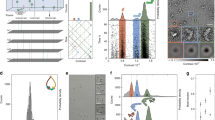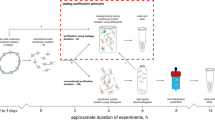Abstract
THE commercial availability of zonal rotors and centrifuges within the past 3–4 years has permitted the exploitation of zonal centrifugation for large scale fractionation of cellular components. In particular, attention has been focused on the isolation of relatively large components such as cell organelles and sub-fractions, viruses and RNA, although the technique has also been applied to enzyme purification1.
This is a preview of subscription content, access via your institution
Access options
Subscribe to this journal
Receive 51 print issues and online access
$199.00 per year
only $3.90 per issue
Buy this article
- Purchase on Springer Link
- Instant access to full article PDF
Prices may be subject to local taxes which are calculated during checkout
Similar content being viewed by others
References
Setlow, B., and Lowenstein, J. M., J. Biol. Chem., 242, 607 (1967).
Self, C. H., and Weitzman, P. D. J., Abst. of the Sixth FEBS Meeting, Madrid, No. 249 (1969).
Author information
Authors and Affiliations
Rights and permissions
About this article
Cite this article
SELF, C., WEITZMAN, P. Separation of Isoenzymes by Zonal Centrifugation. Nature 225, 644–645 (1970). https://doi.org/10.1038/225644a0
Received:
Issue Date:
DOI: https://doi.org/10.1038/225644a0
This article is cited by
-
Synthese der Enzyme des Tricarbons�ure-Cyclus in Hydrogenomonas eutropha Stamm H 16
Archiv f�r Mikrobiologie (1972)
-
NADP- und NAD-spezifische Isocitrat-Dehydrogenase in Hydrogenomonas eutropha Stamm H 16
Archiv f�r Mikrobiologie (1972)
Comments
By submitting a comment you agree to abide by our Terms and Community Guidelines. If you find something abusive or that does not comply with our terms or guidelines please flag it as inappropriate.



